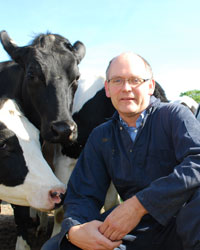In the wake of published studies speaking to efficacy of intramammary treatments for gram-negative clinical mastitis, namely a five-day ceftiofur treatment option, experts weigh in on the pros and cons, specifically, of the five-day treatment plan.

For background, Ynte H. Schukken, DVM, Ph.D., professor, Cornell University in Ithaca, New York, helped lead a 2011 study on the effectiveness of five-day ceftiofur intramammary treatment on nonsevere gram-negative clinical mastitis. Schukken is pictured at right.
The randomized clinical trial detected bacteria in milk samples from cows with mild-to-moderate clinical mastitis. Clinical gram-negative mastitis classified as “nonsevere” that was treated with ceftiofur showed significant increase in bacteriological cure (73 percent), compared with nontreated controls (38 percent) in Escherichia coli-infected or Klebsiella-infected animals.
Schukken says this is the first peer-reviewed study showing the effectiveness of treating gram-negative mastitis in dairy cows.
“(We found that) five-day therapy with ceftiofur is effective for E. coli-infected and Klebsiella-infected quarters, not for all gram-negatives.”
In a paper presented at the National Mastitis Council’s 2013 annual meeting, Schukken and colleagues evaluated noninferiority of two intramammary treatments for nonsevere, clinical mastitis: a first-generation cephalosporin (cephapirin, two treatments) and a third-generation cephalosporin (ceftiofur, five treatments, once daily).
Bacteriological cure was recognized in 71 of 97 ceftiofur-treated cases and 59 of 96 cephapirin-treated cases. Though there was essentially no difference between ceftiofur and cephapirin in gram-positive bacteria results, the bacteriological cure was greater in gram-negative bacteria (79 percent for ceftiofur versus 50 percent for cephapirin).

Based on the 2011 findings, Alan Langill (right), DVM MBA, general manager, Indiana Milk Quality Inc., advocates the five-day treatment of mild and moderate clinical coliform mastitis, citing the Cornell University research as “the best evidence we have for extended treatment.”
In agreement is Roger L. Saltman, DVM, MBA, group director, Cattle and Equine Technical Services, Zoetis, who calls the 2011 Schukken-led study “groundbreaking,” because it demonstrated significant impact on true bacterial cure rates for dairy cattle infected with coliform mastitis. Saltman is pictured at right.
Bacteriological cure, Langill adds, must be differentiated from a "clinical cure" because in some cases the milk may return to normal but the bacteria may still remain in low (subclinical) numbers in the mammary gland, leading to potential recurrence of mastitis.
“Improved bacterial cure of clinical coliform mastitis through extended antibiotic treatment may reduce or control the reservoir of these strains of coliform,” he says.
Yet Langill acknowledges controversy within the veterinary profession and the dairy industry on whether mild coliforms need be treated at all. In fact, last summer Langill notes that the Veterinary Clinics of North America published an issue addressing mastitis; one chapter on coliform mastitis management “clearly leaned to nontreatment of mild coliform mastitis,” he says.
“So we clearly still have two camps of thought in the veterinary community inhabited by very intelligent researchers and veterinarians,” he says.

Adds Saltman (pictured at right), “Historically, veterinarians and producers have considered gram-negative (coliform) mastitis to be ‘untreatable’ since virtually all of the approved mastitis treatments used antibiotics that were only effective against gram-positive bacteria.”
He says that many veterinarians and producers have considered coliform mastitis to be an infection in the udder and in the system of the cow (Grade 3 or severe mastitis), which would require more intense therapy than intramammary treatment.
While true in the past, Saltman says increasingly, mastitis due to coliform bacteria is found in about 25 percent of samples from cows that are only showing mild signs of infection in which only the milk looks abnormal (Grade 1) or moderate signs of infection in which the milk looks abnormal and one or more udder quarters are inflamed (Grade 2).”
In many herds where bacterial cultures are done on all mild-to-moderate mastitis cases, 15 percent to 40 percent of the typically mild-to-moderate “everyday” mastitis cases are shown to be due to gram-negative (typically E. coli) bacteria, according to Saltman.
Therefore, Saltman suggests that many veterinarians and producers have rethought the “conventional wisdom” and have started using the five-day treatment with Spectramast LC on gram-negative and gram-positive mastitis.
In Langill’s case, his bias is to treat all clinical mastitis intramammary for five days; sometimes he adds three to five days of treatment if the milk has not returned to normal, especially since Spectramast LC has an eight-day treatment label, the only extended therapy treatment for coliform mastitis.
Despite his treatment preference, he cites an economic drawback to extended treatment.
“You end up dumping a lot of milk, the major cost of treatment, especially in high-producing cows. The cost of dumped milk can be remediated somewhat by using it for feeding calves after it has been properly pasteurized and processed,” he says.
Regardless, Langill recommends culturing clinical mastitis for treatment decisions or as a monitoring tool for troubleshooting mastitis outbreaks.
“Treat all clinical mastitis for five days, but review culture results on a regular basis,” he says. “I am not a big fan of on-farm culturing as it leads to errors, tends to become oversimplified and can miss infections, such as yeasts and mycoplasma. If on-farm culturing is done send samples in periodically to a good lab to verify that the on-farm results match with good lab results.”
Allan Britten, DVM, laboratory director, Udder Health Systems in Idaho, observes another issue on the rise regarding mastitis. Because dairy farms have been so successful in treating gram-positive cases promptly, he suggests that some producers and veterinarians are saying there is no gram-positive risk, and there is no longer a contagious threat.
“They say, ‘Cows do just as well if we don’t treat at all,’” he says.
“But the reality is that an increased frequency of gram-positive mastitis cases can start to come back. If you take treatment all intramammary treatment away it tends to backfire in most herds eventually,” he says.
That said, Britten champions the selective treatment approach.
“Inherent in the decision on whether to treat is the need for some kind of culture system, either with the local veterinarian or an on-farm culture service,” Britten notes. “There are cases where you can’t measure any benefit. There isn’t much to do to help those animals, because there’s too much tissue damage,” he says.
As for Britten, he advocates use of intramammary antibiotics in many cases, choosing to proactively treat organisms caused by gram-positive cases.
He says that typically on dairy farms, mastitis cases fall into the 50-30-20 category, where roughly half of infections that you culture have no growth.
“These 'no-growths' don't mean they don’t have mastitis – most probably do. But half are safely categorized as not good for treatment, as there are no live bacteria for the antibiotic to kill,” he says.
Then, typically 30 percent have gram-positive bacteria and 20 percent gram-negative, or vice versa.
Any dairy would easily benefit economically from setting up culture services to determine whether there are bacteria in the gland or not. Additionally, there should be veterinary oversight of the decision-making process, based on diagnostic culture on whether intramammary treatment is appropriate, he says.
“There is zero question that since the introduction of intramammary antibiotics, there has been dramatic reduction in overall infection since the 1950s – sometimes it’s still two steps forward, one step back but we are progressing,” he says. PD
Stephanie Skernivitz is a freelancer based in Cleveland, Ohio.





